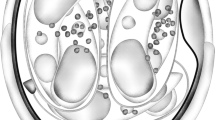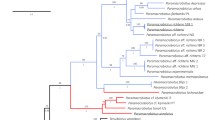Abstract
The genus Hyphodermella was studied based on material from the western Mediterranean area (France, Italy, Spain, Portugal and Morocco) where the following three species have been recognized: H. corrugata (Fr.) J. Erikss. & Ryvarden, widely distributed, H. densa Melo & Hjortstam, only known from Portugal, and H. rosae (Bres.) Nakasone described from Italy. Twenty-one new ITS nrDNA sequences from these species, including the holotype collection of H. rosae and the paratype of H. densa, were aligned with one obtained from GenBank. The molecular results show that these collections are distributed in two highly supported monophyletic clades: one corresponds to H. corrugata, and the other one with H. densa and H. rosae collections. Morphological studies, including the type collections of the three taxa, show significant differences between the clades if we take into account the size of basidia and spores. The present study confirms H. corrugata as an independent species of H. rosae and H. densa, and that H. densa and H. rosae are conspecific; consequently, H. densa is a synonym of H. rosae. This last species is widely distributed in the Mediterranean area (France, Italy, Spain and Portugal) and as frequent as H. corrugata. Comments are offered on sequencing the barcode from types and well-annotated specimens.




Similar content being viewed by others
References
Altermatt C, Mornand J (1991) Contribution à la connaissance des champignons de Maine-et-Loire. 1. Aphyllophoromycetidae (Rea) Bon p.p. Auriculariomycetidae Locq. p.p. Bull Soc Mycol Fr 107:53–84
Altschul SF, Madden TL, Schäffer AA, Zhang J, Zhang Z, Miller W, Lipman DJ (1997) Gapped BLAST and PSI-BLAST: a new generation of protein database search programs. Nucleic Acids Res 25:3389–3402
Beltrán Tejera E (2004) Fungi. In: Izquierdo I, Martín JL, Zurita N, Arechavaleta M (eds) Lista de las especies silvestres de Canarias (hongos, plantas y animales terrestres). Consejería de Medio Ambiente y Ordenación Territorial, Gobierno de Canarias, pp 21–57
Bernicchia A, Venturella G, Saitta A, Gorjón SP (2007) Aphyllophoraceous wood-inhabiting fungi on Fagus sylvatica in Italy. Mycotaxon 101: 229-232 [Online at http://www.mycotaxon.com/resources/checklists]
Boidin J, Candoussau F, Gilles G (1986) Bambusicolous fungi from the Southwest of France II. Saprobic Heterobasidiomycetes, resupinate Aphyllophorales and Nidulariales. Trans Mycol Soc Jpn 27:463–471
Bourdot H, Galzin A (1927) Hyménomycètes de France. Hetérobasidiés – Homobasidiés Gymnocarpes. Reprint 1967. Biblioth Mycol 23. J. Cramer, Lehre
Breitenbach J, Kränzlin F (1986) Champignons de Suisse, vol. 2, Hétérobasidiomycétes, Aphyllophorales, Gasteromycètes. Mykologie, Luzern
Brock PM, Döring H, Bidartondo M (2008) How to know unknown fungi: the role of a herbarium. New Phytol 18:719–724
Bruns TD, Fogel R, Taylor JW (1990) Amplification and sequencing of DNA from fungal herbarium specimens. Mycologia 82:175–184
Dämon W (2001) Die corticioiden Basidienpilze des Bundeslandes Salzburg (Österreich): Floristik, Lebensräume und Substratökologie. Biblioth Mycol 189:1–413
Dueñas M, Telleria MT (1988) Catálogo de los corticiáceos y poliporáceos, s.l. (Aphyllophorales, Basidiomycotina) de la micoflora cántabro-astur. Ruizia 5:1–262
Eriksson J, Ryvarden L (1976) The Corticiaceae of North Europe, vol. 4, Hyphodermella – Mycoacia. Fungiflora, Oslo
Farris JS (1989) The retention index and the rescaled consistency index. Cladistics 5:417–419
Felsenstein J (1985) Confidence limits on phylogenies: an approach using the bootstrap. Evolution 39:783–791
Fries EM (1874) Hymenomycetes Europaei. Ed. Berling, Uppsala
Gardes M, Bruns TD (1993) ITS primers with enhanced specifity for basidiomycetes –application to the identification of mycorrhizae and rusts. Mol Ecol 2:113–118
Gilbertson RL, Desjardin DE, Rogers JD, Hemmes DE (2001) Fungi from the Mamane-Naio vegetation zone of Hawaii. Fungal Divers 6:35–68
Ginns JH, Lefebvre ML (1993) Lignicolous Corticioid Fungi (Basidiomycota) of North America. Systematics, distribution, and ecology. Mycol Mem 19:1–247
Grosse Brauckmann H (1990) Corticioide Basidiomyceten in der Bundesrepublik Deutschland: Funde 1960 bis 1989. Z Mykol 56:95–130
Hallenberg N (1978) Wood-fungi (Corticiaceae, Coniophoraceae, Lachnocladiaceae, Thelephoraceae) in N. Iran 1. Iran J Plant Pathol 14:38–87
Heller A (1989) Zur Kenntnis der Pilzflora Nordwestdeutschlands: Resupinate Aphyllophorales und Heterobasidiomyceten. Int J Mycol Lichenol 4:35–58
Hjortstam K (1984) Some new and notheworthy Basidiomycetes (Aphyllophorales) from Nepal. Mycotaxon 20:133–151
Hjortstam K, Ryvarden L (1986) Some new and noteworthy fungi (Aphyllophorales, Basidiomycetes) from Iguazú, Argentina. Mycotaxon 25:539–567
Hjortstam K, Ryvarden L (1997) Corticioid species (Basidiomycotina, Aphyllophorales) from Colombia collected by Leif Ryvarden. Mycotaxon 64:229–241
Hjortstam K, Ryvarden L (2007) Checklist of corticioid fungi (Basidiomycotina) from the tropics, subtropics and the southern hemisphere. Synopsis Fung 22:27–146
Huelsenbeck JP, Ronquist F, Nielsen R, Bollback JP (2001) Bayesian inference of phylogeny and its impact on evolutionary biology. Science 294:2310–2314
Kluge AG, Farris JS (1969) Quantitative phyletics and the evolution of anurans. Syst Zool 18:1–32
Larget B, Simon DL (1999) Markov chain Monte Carlo algorithms for the Bayesian analysis of phylogenetic trees. Mol Biol Evol 16:750–759
Larsson KH (2007) Re-thinking the classification of corticioid fungi. Mycol Res 111:1040–1063
Larsson E, Jacobsson S (2004) Controversy over Hygrophorus cossus settled using ITS sequence data from 200-year-old type material. Mycol Res 108(7):781–786
Legon NW, Henrici A, Roberts PJ, Spooner BM, Watling R (2005) Checklist of British & Irish Basidiomycota. Royal Botanic Gardens, Kew
Lucchini G, Zenone E, Martini E, Pellandini W (1990) I macromiceti delle Bolle di Magadino. Boll Soc Ticinese Sci Nat 78:33–132
Maekawa N (2002) Corticioid fungi (Basidiomycetes) collected in Sichuan province, China. Mycotaxon 83:81–95
Malençon G (1957) Prodrome d’une flore micologique du Moyen-Atlas. 4º Contribution. Bull Soc Mycol Fr 73:289–330
Martín MP, Winka K (2000) Alternative methods of extracting and amplifying DNA from lichens. Lichenologist 32:189–196
Martín MP, Högberg N, Nylund JE (1998) Molecular analysis confirms morphological reclassification of Rhizopogon. Mycol Res 102(7):855–858
Melo I, Cardoso J (1985) Check list of the Portuguese non-poroid Aphyllophorales. Portug Acta Biol, B 14:37–104
Melo I, Hjortstam K (2003) A new species of Hyphodermella (Basidiomycetes, Aphyllophorales) from Portugal. Nova Hedwigia 77:351–355
Nakasone K (2008) Type studies of corticioid Hymenomycetes described by Bresadola. Cryptog Mycol 29:231–257
Page RDM (1996) TreeView, an application to display phylogenetic trees on personal computers. Comp Appl Biosci 12:357–358
Rambaut A (2002) Se-Al: sequences alignment editor v2.0a11.Edinburgh: Institute of Evolutionary Biology, University of Edinburgh. http://tree.bio.ed.ac.uk/software/
Rodríguez F, Oliver JF, Martín A, Medina JR (1990) The general stochastic model of nucleotide substitution. J Theor Biol 142:485–501
Ronquist F, Huelsenbeck JP (2003) MrBayes 3: Bayesian phylogenetic inference under mixed models. Bioinformatics 19:1572–1574
Ryvarden L (2007) Studies in Neotropical polypores, 23. New and interesting wood-inhabiting fungi from Belize. Synop Fung 23:32–50
Sundquist T, Bessetti J (2005) Identifying and preventing DNA contamination in a DNA-Typing Laboratory. Profiles in DNA. September: 11-13. www.promega.com
Swofford DL (2003) PAUP*. Phylogenetic analysis using parsimony (*and other methods). Sinauer, Sunderland
Telleria MT (1984) Aphyllophorales in itinere per Maroccanum Regnum a nobis lectae. Anales Jard Bot Madrid 40:303–319
Telleria MT (1990) Annotated list of the Corticiaceae, sensu lato (Aphyllophorales, Basidiomycotina), for Peninsular Spain and Balearic Islands. Biblioth Mycol 135:1–152
Tomsovsky M, Ryvarden L (2008) Gloeoporus dichrous var. niger comb. nov. Mycotaxon 105:171–174
Volk TJ, Burdsall HH, Reynolds K (1994) Checklist and host index of wood-inhabiting fungi of Alaska. Mycotaxon 52(1):1–46
Wakefield EM (1952) New or rare British Hymenomycetes (Aphyllophorales). Trans Br Mycol Soc 35:34–65
White TJ, Bruns T, Lee S, Taylor J (1990) Amplification and direct sequencing of fungal ribosomal RNA genes for phylogenetics. In: Innis MA, Gelfand DH, Sninsky JJ, White TJ (eds) PCR protocols: a guide to methods and applications. Academic, San Diego, pp 315–322
Wu SH (1990) The Corticiaceae (Basidiomycetes) subfamilies Phlebioideae, Phanerochaetoideae and Hyphodermoideae in Taiwan. Acta Bot Fenn 142:1–123
Acknowledgements
Financial support was provided by DGI project CGL2006-12732-C02-01. We are grateful to Karl-Henrik Larsson (Natural History Museum, Oslo) for critically reviewing the manuscript, to Roy Watling (Caledonian Mycological Enterprises) for checking the English, to Fátima Durán (RJB, CSIC) for providing technical assistance, to Majda Valjavec-Gratian (NIH/NLM/NCBI) for help in extracting information about the holotype sequences in the NCBI database, to Svengunnar Rymann (UPS), and to the curators of PC, TR, and UPS, for their invaluable help.
Author information
Authors and Affiliations
Corresponding author
Rights and permissions
About this article
Cite this article
Telleria, M.T., Dueñas, M., Melo, I. et al. Morphological and molecular studies of Hyphodermella in the Western Mediterranean area. Mycol Progress 9, 585–596 (2010). https://doi.org/10.1007/s11557-010-0666-5
Received:
Revised:
Accepted:
Published:
Issue Date:
DOI: https://doi.org/10.1007/s11557-010-0666-5




